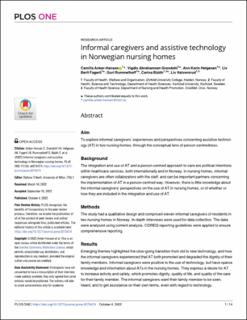| dc.contributor.author | Anker-Hansen, Camilla | |
| dc.contributor.author | Grøndahl, Vigdis Abrahamsen | |
| dc.contributor.author | Helgesen, Ann Karin | |
| dc.contributor.author | Fagerli, Liv Berit | |
| dc.contributor.author | Rummelhoff, Guri Kirsten Rosseland | |
| dc.contributor.author | Bååth, Carina Barbro | |
| dc.contributor.author | Halvorsrud, Liv Torill | |
| dc.date.accessioned | 2023-01-23T15:15:55Z | |
| dc.date.available | 2023-01-23T15:15:55Z | |
| dc.date.created | 2022-10-07T09:08:00Z | |
| dc.date.issued | 2022 | |
| dc.identifier.citation | PLOS ONE. 2022, 17(10), Artikkel e0275474. | en_US |
| dc.identifier.issn | 1932-6203 | |
| dc.identifier.uri | https://hdl.handle.net/11250/3045454 | |
| dc.description.abstract | Aim
To explore informal caregivers’ experiences and perspectives concerning assistive technology (AT) in two nursing homes, through the conceptual lens of person-centredness.
Background
The integration and use of AT and a person-centred approach to care are political intentions within healthcare services, both internationally and in Norway. In nursing homes, informal caregivers are often collaborators with the staff, and can be important partners concerning the implementation of AT in a person-centred way. However, there is little knowledge about the informal caregivers’ perspectives on the use of AT in nursing homes, or of whether or how they are included in the integration and use of AT.
Methods
The study had a qualitative design and comprised eleven informal caregivers of residents in two nursing homes in Norway. In-depth interviews were used for data collection. The data were analysed using content analysis. COREQ reporting guidelines were applied to ensure comprehensive reporting.
Results
Emerging themes highlighted the slow-going transition from old to new technology, and how the informal caregivers experienced that AT both promoted and degraded the dignity of their family members. Informal caregivers were positive to the use of technology, but have sparse knowledge and information about ATs in the nursing homes. They express a desire for AT to increase activity and safety, which promotes dignity, quality of life, and quality of the care for their family member. The informal caregivers want their family member to be seen, heard, and to get assistance on their own terms, even with regard to technology.
Conclusion
Before AT can be implemented, informal caregivers need to be informed and listened to and included in the processes. Through their stories, one can form an idea of how important a person-centred approach is to contributing to individually tailored and introduced AT in collaboration with the informal caregivers. | en_US |
| dc.language.iso | eng | en_US |
| dc.publisher | Public Library of Science | en_US |
| dc.rights | Navngivelse 4.0 Internasjonal | * |
| dc.rights.uri | http://creativecommons.org/licenses/by/4.0/deed.no | * |
| dc.title | Informal caregivers and assistive technology in Norwegian nursing homes | en_US |
| dc.type | Peer reviewed | en_US |
| dc.type | Journal article | en_US |
| dc.description.version | publishedVersion | en_US |
| dc.rights.holder | © 2022 Anker-Hansen et al. | en_US |
| dc.subject.nsi | VDP::Medisinske Fag: 700::Helsefag: 800::Sykepleievitenskap: 808 | en_US |
| dc.source.volume | 17 | en_US |
| dc.source.journal | PLOS ONE | en_US |
| dc.source.issue | 10 | en_US |
| dc.identifier.doi | 10.1371/journal.pone.0275474 | |
| dc.identifier.cristin | 2059413 | |
| dc.source.articlenumber | e0275474 | en_US |
| cristin.ispublished | true | |
| cristin.fulltext | original | |
| cristin.qualitycode | 1 | |

